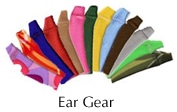When I first saw physical protection products for use over BTE hearing aids, they were rubber and reminded me of you know what. I had to use a tubing stretcher sometimes to get it on and I was exhausted and not satisfied in anyway after it was completed. I am so glad things have changed!
Today, the product I’m reviewing (others will be introduced in future blogs) is Ear Gear’s Hearing Instrument Armor. I have used these for a variety of reasons in my office. The main reasons were for moisture and particle protection over the hearing aid. I have also gotten them for the option of having a clipped cord to add a layer of security. Although on the back of every package it states the cord is “designed to improve retention it will not prevent the loss of hearing instruments.”
One patient that I had use the armor covering with a cord, was a mature adult who liked to hike and be active. He wanted more security as he had lost a BTE instrument and wanted to do everything he could to not duplicate that incident. He had to stay in RICs or BTEs due to his sensitivity to occlusion effect. He also decided why not flaunt it? Plus, we were able to order him bright colors which helped him find it if dropped on his neutral colored carpet.
The Ear Gear protection is relatively easy to put on an instrument, unlike the extremes I went to with the rubber type. The directions also state that Ear Gear can be washed in a mild detergent, rinsed and let drip dry. Most of my patients who have Ear Gear, also have a dehumidifier of some kind and we advise them to put the Ear Gear in these as well, when not in use, to help diminish the moisture.
Ear Gear models are made for CI units, bone anchored units and different sizes and colors for all BTE models. Some hearing aids are an in-between size, so we keep some stock samples in the office to experiment with to determine what size works best and to make sure the patients can handle putting them on and taking them off.
When narrowing down a patient’s issues with moisture, we have them bring in their hearing aids for inspection and to pinpoint if they are “head sweaters” or if there is a reaction with skin oil etc. We like to have an arsenal of choices for our patients, including dehumidifiers, in all price points and Ear Gear is one option.
In full disclosure, Ear Gear does advertise on our HHTM site.
What are other moisture/debris solutions have you found?







